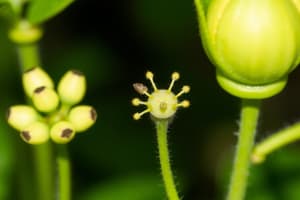Podcast
Questions and Answers
What is the primary focus of phytochemistry?
What is the primary focus of phytochemistry?
- The chemical properties of inorganic substances.
- The pharmacological interactions of synthetic drugs.
- The study of primary metabolites in animals.
- The chemical structure and biological activity of plant secondary metabolites. (correct)
Which of the following is NOT classified as a primary metabolite?
Which of the following is NOT classified as a primary metabolite?
- Alkaloids (correct)
- Fats
- Proteins
- Carbohydrates
Which of the following best describes secondary metabolites?
Which of the following best describes secondary metabolites?
- Pharmacologically active compounds serving various ecological functions. (correct)
- Produced by plants primarily for structural support.
- Indirectly related to the plant's photosynthetic process.
- Essential for basic metabolic functions.
Among the following classifications, which one is NOT a category of plant constituents?
Among the following classifications, which one is NOT a category of plant constituents?
What suffix is commonly used to indicate a chemical class of glycosides?
What suffix is commonly used to indicate a chemical class of glycosides?
What type of information can be derived from the nomenclature of plant secondary metabolites?
What type of information can be derived from the nomenclature of plant secondary metabolites?
Which of the following statements is true regarding plant active constituents?
Which of the following statements is true regarding plant active constituents?
What are bitter principles commonly referred to as?
What are bitter principles commonly referred to as?
Which extraction method utilizes a Soxhlet extractor and is less time consuming?
Which extraction method utilizes a Soxhlet extractor and is less time consuming?
What is a significant disadvantage of steam distillation?
What is a significant disadvantage of steam distillation?
What is a key benefit of supercritical fluid extraction using CO2?
What is a key benefit of supercritical fluid extraction using CO2?
Which extraction technique is characterized by the use of ultrasound and cavitation?
Which extraction technique is characterized by the use of ultrasound and cavitation?
What is an appropriate use of microwave-assisted extraction?
What is an appropriate use of microwave-assisted extraction?
What characteristic makes supercritical fluid extraction distinct from other methods?
What characteristic makes supercritical fluid extraction distinct from other methods?
Why is continuous hot extraction not suitable for large amounts of plant material?
Why is continuous hot extraction not suitable for large amounts of plant material?
What is a common limitation of ultrasonic assisted extraction?
What is a common limitation of ultrasonic assisted extraction?
Which extraction method involves soaking plant material in a solvent with frequent stirring?
Which extraction method involves soaking plant material in a solvent with frequent stirring?
What does the principle 'like dissolves like' refer to in the context of phytochemical extraction?
What does the principle 'like dissolves like' refer to in the context of phytochemical extraction?
What is the primary purpose of percolation in phytochemical extraction?
What is the primary purpose of percolation in phytochemical extraction?
Which extraction method is least suited for thermolabile constituents?
Which extraction method is least suited for thermolabile constituents?
What primary characteristic distinguishes infusion from decoction?
What primary characteristic distinguishes infusion from decoction?
What is the main disadvantage of the maceration method of extraction?
What is the main disadvantage of the maceration method of extraction?
In which phytochemical extraction technique is the plant material boiled in water for a specified duration?
In which phytochemical extraction technique is the plant material boiled in water for a specified duration?
Which statement accurately describes the process of percolation in phytochemical extraction?
Which statement accurately describes the process of percolation in phytochemical extraction?
What is the primary advantage of Solid Phase MicroExtraction (SPME) compared to traditional extraction methods?
What is the primary advantage of Solid Phase MicroExtraction (SPME) compared to traditional extraction methods?
Which method is most appropriate for isolating volatile oils from a mixture?
Which method is most appropriate for isolating volatile oils from a mixture?
In the context of liquid/liquid extraction, what factor primarily determines the efficiency of separation?
In the context of liquid/liquid extraction, what factor primarily determines the efficiency of separation?
What is a common use of a rotatory evaporator in the concentration of plant extracts?
What is a common use of a rotatory evaporator in the concentration of plant extracts?
Which of the following is NOT a method for isolation of pure compounds in plant extraction?
Which of the following is NOT a method for isolation of pure compounds in plant extraction?
In which scenario is solvent/solvent precipitation most effectively utilized?
In which scenario is solvent/solvent precipitation most effectively utilized?
What role do natural products play in modern medicine as precursors for semisynthetic compounds?
What role do natural products play in modern medicine as precursors for semisynthetic compounds?
Why is chromatography specifically important in the isolation of compounds from plant extracts?
Why is chromatography specifically important in the isolation of compounds from plant extracts?
Flashcards are hidden until you start studying
Study Notes
Introduction to Phytochemistry
- Phytochemistry is the study of chemical compounds found in plants.
- It focuses on the structure, biosynthesis, occurrence, and biological activity of plant secondary metabolites.
- It is an interdisciplinary field that draws from biochemistry, organic chemistry, and pharmacology.
Plant Constituents
- Plant constituents are organic substances formed and accumulated by plants.
- Primary metabolites are essential for life and include carbohydrates, fats, and proteins.
- Secondary metabolites are pharmacologically active compounds produced by specific organisms or groups of organisms.
- Secondary metabolites function as biodefense mechanisms, attractants, and dyes.
- Some natural products can be classified as both primary and secondary metabolites.
Classification of Plant Secondary Metabolites
- Plant secondary metabolites are classified according to their chemistry and common physical properties.
- Types of secondary metabolites include:
- Volatile oils
- Resins and resin combinations
- Alkaloids
- Carbohydrates
- Glycosides
- Bitter principles (bitters)
- Tannins
Nomenclature of Plant Secondary Metabolites
- Trivial names of plant secondary metabolites are derived from:
- The name of the discoverer: pelletierine
- The name of the plant, genus, species: Salicin
- Pharmacological action: emetine
- Prefixes indicate added substitutions:
- Hydroxy-, methoxy-, methyl-, dihydro-,
- Prefixes indicate removed substitutions:
- Deoxy-, demethoxy-, demethyl-, dehydro-, nor-
- Suffixes usually indicate the chemical class:
- -oside (glycoside)
- -ine (alkaloid)
- -one (ketone)
Plants Vs Phytochemicals
- The active constituents of a plant vary in different areas, climates, and seasons.
- Active constituents usually exist with other compounds that can have toxic or unpredictable activity.
- Phytochemicals can be assayed and used in accurately measured doses.
Roadmap to Phytochemistry
- Fractionation steps are essential in obtaining active compounds from plants.
Extraction of Plant Metabolites
- The first step in obtaining an active compound is extraction.
- Extraction is the process of separating medically active compounds from plant or animal tissue using selective solvents.
- Extraction solvents are chosen based on their ability to selectively dissolve plant active constituents.
- The solubility of a molecule in a solvent is affected by their polarity: "like dissolves like".
Traditional Extraction Methods
- Maceration/Digestion:
- Simple method for small or large amounts.
- Powdered plant is soaked in solvent with frequent stirring.
- Gentle heat applied = digestion.
- Time-consuming.
- Infusion:
- Plant soaked in hot water for a short period.
- Used in traditional medicine.
- Decoction:
- Plant boiled with water for 15-30 minutes.
- For polar water-soluble compounds.
- Not suitable for thermolabile constituents.
- Percolation:
- Maceration followed by a continuous slow flow of fresh solvent through plant material.
- Time-consuming.
- Not suitable for plants containing mucilage.
- Continuous Hot Extraction (Soxhlet Extraction):
- Uses a special equipment (Soxhlet extractor).
- Continuous process: solvent is evaporated, recondensed, and reused.
- Less time-consuming.
- Uses lower volumes of solvent.
- Not suitable for large amounts.
- Steam Distillation:
- Used for volatile oils.
- Plant heated with water or steam.
- Vapor contains steam and volatile constituents.
- Vapor is condensed and separated into two immiscible liquids.
- Only for volatile constituents.
- Not suitable for thermolabile compounds.
Modern Extraction Methods
- Supercritical Fluid Extraction (SFE):
- Uses liquefied gas (CO2 or N2O) under pressure and temperature.
- Extracts target compounds from solid samples.
- CO2 is inert, non-inflammable, easy to remove, and its polarity can be adjusted.
- Extracts closely resemble natural compounds, minimizing hydrolysis, decomposition and rearrangement.
- Ultrasonic Assisted Extraction (UAE):
- Uses ultrasound pulses (20 KHz).
- Breakdown cell walls and enhances extraction by creating cavitation.
- Not suitable for large amounts.
- Microwave-Assisted Extraction (MAE):
- Heats solvent in contact with the sample using microwave energy.
- Heat generated by microwaves enhances solvent penetration.
- Reduces cost, extraction time, energy, and solvent consumption.
- Solid Phase Extraction (SPE):
- Physical extraction/fractionation process using pre-packed columns with stationary phases.
- Solid Phase Microextraction (SPME):
- Used for analysis of volatile oils.
- Adsorptive phase: silicone derivative fibers.
- Reduces solvent consumption and plant material.
- Less opportunity for oxidation of volatiles.
- Rapid and reproducible.
Fractionation of Extract
- Solvent/Solvent Precipitation:
- Mixing extract with a less polar miscible solvent to precipitate compounds.
- Liquid/Liquid Extraction:
- Uses two immiscible solvents.
- Depends on the partition coefficient of solutes.
- Can be done in single or multiple contacts.
Concentration
- Rotatory Evaporator (Rotavap):
- Removes excess solvents by applying heat to a rotating flask under reduced pressure.
- Lyophilizer:
- Freeze-drying method for sensitive compounds.
Isolation of Pure Compounds
- Sublimation:
- Used for compounds that directly transition from solid to gas (e.g. caffeine).
- Fractional Distillation:
- Separates liquids with different boiling points (e.g. volatile oils).
- Fractional Crystallization:
- Separates compounds based on differences in solubility.
- Chromatography:
- Separates compounds based on their distribution between a stationary phase and a mobile phase.
Natural Products in Modern Medicine
- Useful Drugs:
- Compounds that cannot be commercially produced by synthesis (e.g. morphine, penicillin, ergotamine, ergometrine, vincristine).
- Precursor for Semisynthetic Compounds:
- Modified to produce more effective or less toxic drugs (e.g. salicin → aspirin).
- Template for Synthetic Analogs:
- Used to produce synthetic variations through drug design (e.g. procaine and related local anesthetics).
Studying That Suits You
Use AI to generate personalized quizzes and flashcards to suit your learning preferences.




